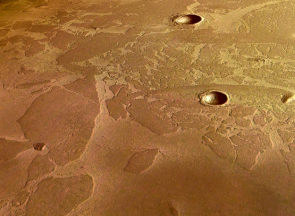The enigma of methane on Mars
Methane, an indicator of life?
Methane (CH4) is an organic molecule present in gaseous form in the Earth's atmosphere. More than 90% of methane on our home planet is produced by living organisms. The recent detection of plumes of methane in the northern hemisphere of Mars is of great interest because of its potential biological origin, though other explanations may also be possible.
 |
| Elysium Planitia - raised levels of methane were detected by a Mars Express instrument Credit: ESA/DLR/FU Berlin (G. Neukum) |
Methane breaks up in the presence of ultraviolet solar radiation. Based on photochemical models and on the current understanding of the composition of the Martian atmosphere, methane has a chemical lifetime of about
One possibility is a biological origin. The discovery of microbial life 2 to 3 kilometres beneath the surface of the Witwatersrand basin in South Africa led scientists to consider that similar organisms could live, or have lived in the past, below the permafrost layer on Mars. By analogy with Earth, the biological origin of Martian methane could be explained by the existence of micro-organisms, called methanogenes, existing deep under the surface, and producing methane as a result of their metabolism.
If the methane on Mars is biotic, two scenarios could be considered: either long-extinct microbes, which disappeared millions of years ago, have left the methane frozen in the Martian upper subsurface, and this gas is being released into the atmosphere today as temperatures and pressure near the surface change, or some very resistant methane-producing organisms still survive.
An alternative explanation is that the methane is geological in origin. It could be produced, for example, by the oxidation of iron, similar to what occurs in terrestrial hot springs, or in active volcanoes. This gas could have been trapped in solid forms of water, or 'cages', that can preserve methane of ancient origin for a long time. These structures are known as 'clathrate hydrates'.
A geochemical process called serpentinisation could also produce the abiotic methane. Serpentinization is a geological low-temperature metamorphic process involving heat, water, and changes in pressure. It occurs when olivine, a mineral present on Mars, reacts with water, forming another mineral called serpentine, in the presence of carbon dioxide and some catalysts. When certain catalysts are also present, the hydrogen combines with the carbon to form methane. On Mars it is possible to find all these primary elements: olivine, carbon dioxide and some catalysts, but the chemical reaction needs liquid water to occur. This implies that, if the Martian methane comes from serpentinisation, it could be related to subsurface hydrothermal activity.
Concentrations of methane have been observed in 2003 and 2006 in three specific regions of Mars: Terra Sabae, Nili Fossae and Syrtis Major, and data suggest that water once flowed over these areas. Deep liquid water areas below the ice layer would be able to provide a habitat for microorganisms, or a favourable place for the hydro-geochemical production of methane. Further processing in the Martian atmosphere may play an important role that accounts for the observed seasonal variability. Whether geochemical or biochemical in origin, the variation in concentrations of methane that has been measured indicates that Mars could still be active today.
One way to confirm the biological origin of methane would be to measure the isotope ratios of carbon and hydrogen, the two elements in methane. Life on Earth tends to use lighter isotopes, for example, more Carbon-12 than Carbon-13, because this requires less energy for bonding.
For further progress to be made in unveiling the origin of methane on Mars, future space missions with new technologies devised to better characterise the Martian environment and its subsurface will be necessary.
Confirming the presence of methane on Mars, a goal of the ExoMars programme
Observations from the Planetary Fourier Spectrometer (PFS) on ESA's Mars Express and from very high spectral resolution spectrometers on ground-based telescopes, have detected variable amounts of methane in the atmosphere of Mars. Could this be evidence for life on Mars? International space agencies are planning an ambitious, long-term Mars Robotic Exploration Programme to find a definitive answer to this most enduring question.
The scientific objectives of the ExoMars programme 2016-2022 include: searching for signs of past and present life on Mars, studying the water and geochemical environment as a function of depth in the shallow subsurface, and investigating Martian atmospheric trace gases and their sources.
To achieve these objectives, ESA’s ExoMars Trace Gas Orbiter, which was launched on 14 March 2016 and arrived at Mars in October 2016, is measuring and mapping methane and other important trace gases with high sensitivity to provide insights into the nature of the source through the study of gas ratios and isotopes.
The 2022 ESA ExoMars Rover will search for two types of life signatures, morphological and chemical, with an accurate study of the geological context. Morphological information related to biological processes may be preserved on the surface of rocks or under the surface. Since the surface of Mars is oxidised, the ExoMars drill has been designed to penetrate the surface and obtain samples from well-consolidated (hard) formations, at various depths, down to 2 metres.
